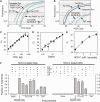Tracking the processing of damaged DNA double-strand break ends by ligation-mediated PCR: increased persistence of 3'-phosphoglycolate termini in SCAN1 cells
- PMID: 24371269
- PMCID: PMC3950721
- DOI: 10.1093/nar/gkt1347
Tracking the processing of damaged DNA double-strand break ends by ligation-mediated PCR: increased persistence of 3'-phosphoglycolate termini in SCAN1 cells
Abstract
To track the processing of damaged DNA double-strand break (DSB) ends in vivo, a method was devised for quantitative measurement of 3'-phosphoglycolate (PG) termini on DSBs induced by the non-protein chromophore of neocarzinostatin (NCS-C) in the human Alu repeat. Following exposure of cells to NCS-C, DNA was isolated, and labile lesions were chemically stabilized. All 3'-phosphate and 3'-hydroxyl ends were enzymatically capped with dideoxy termini, whereas 3'-PG ends were rendered ligatable, linked to an anchor, and quantified by real-time Taqman polymerase chain reaction. Using this assay and variations thereof, 3'-PG and 3'-phosphate termini on 1-base 3' overhangs of NCS-C-induced DSBs were readily detected in DNA from the treated lymphoblastoid cells, and both were largely eliminated from cellular DNA within 1 h. However, the 3'-PG termini were processed more slowly than 3'-phosphate termini, and were more persistent in tyrosyl-DNA phosphodiesterase 1-mutant SCAN1 than in normal cells, suggesting a significant role for tyrosyl-DNA phosphodiesterase 1 in removing 3'-PG blocking groups for DSB repair. DSBs with 3'-hydroxyl termini, which are not directly induced by NCS-C, were formed rapidly in cells, and largely eliminated by further processing within 1 h, both in Alu repeats and in heterochromatic α-satellite DNA. Moreover, absence of DNA-PK in M059J cells appeared to accelerate resolution of 3'-PG ends.
Figures





References
-
- Dedon PC, Goldberg IH. Free-radical mechanisms involved in the formation of sequence- dependent bistranded DNA lesions by the antitumor antibiotics bleomycin, neocarzinostatin, and calicheamicin. Chem. Res. Toxicol. 1992;5:311–332. - PubMed
-
- Povirk LF. DNA damage and mutagenesis by radiomimetic DNA-cleaving agents: bleomycin, neocarzinostatin and other enediynes. Mutat. Res. 1996;355:71–89. - PubMed
-
- Inamdar KV, Pouliot JJ, Zhou T, Lees-Miller SP, Rasouli-Nia A, Povirk LF. Conversion of phosphoglycolate to phosphate termini on 3′ overhangs of DNA double-strand breaks by the human tyrosyl-DNA phosphodiesterase hTdp1. J. Biol. Chem. 2002;276:24323–24330. - PubMed
Publication types
MeSH terms
Substances
Grants and funding
LinkOut - more resources
Full Text Sources
Other Literature Sources

